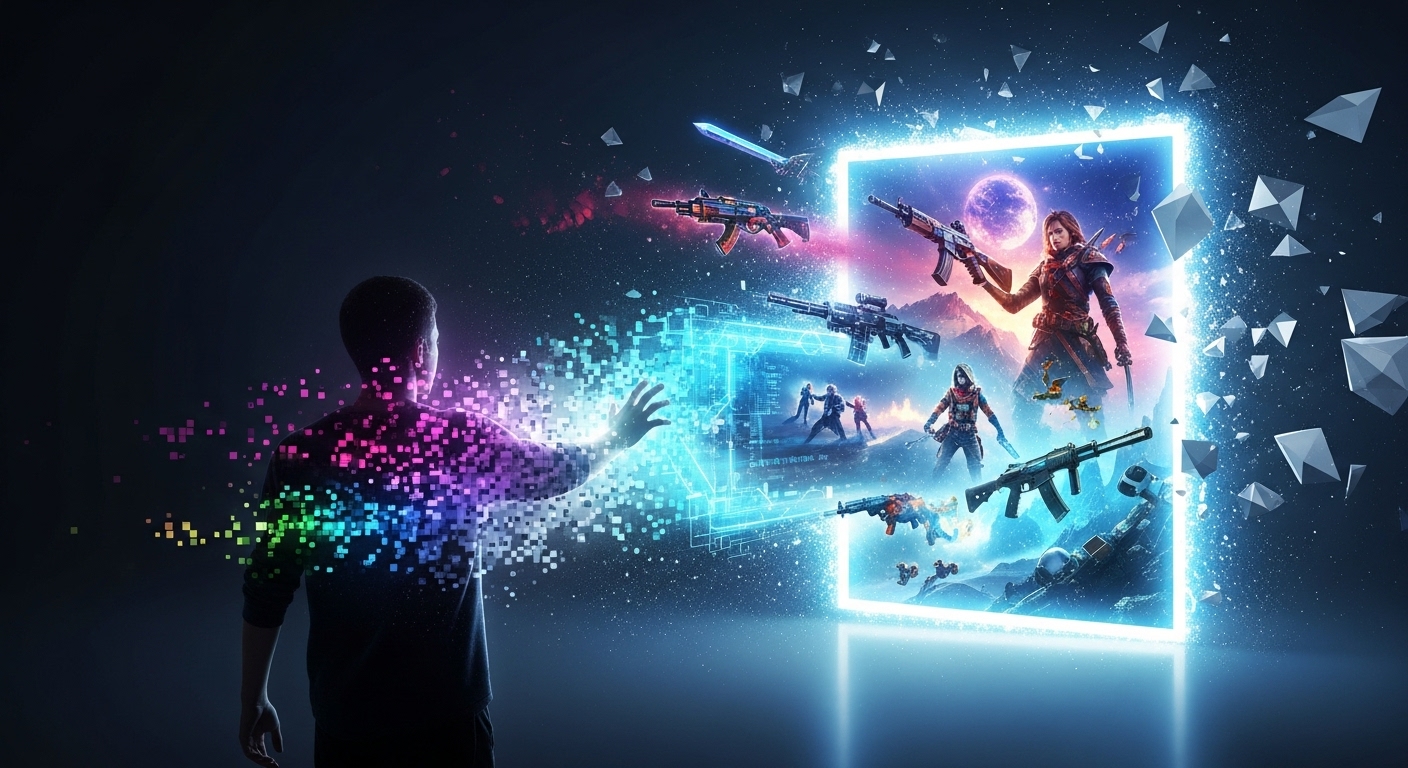Introduction: Gaming’s Journey from Hobby to Cultural Phenomenon
Gaming has come a long way since its early days as a niche hobby enjoyed by a small group of enthusiasts. What once began as a simple diversion on arcade machines has now blossomed into a massive global industry worth billions of dollars. Over the decades, video games have evolved from basic pixelated graphics to sprawling open-world experiences filled with high-definition visuals, lifelike characters, and immersive narratives. Gaming is no longer just a pastime—it’s a cultural phenomenon that influences everything from entertainment to social interaction, education, and even professional careers.
Today, gaming is a central aspect of youth culture and has found its place in mainstream entertainment, rivaling traditional media such as movies, TV shows, and music. The advent of online gaming has created virtual communities, while esports has transformed gaming into a competitive, spectator-driven sport. Mobile gaming has made gaming more accessible than ever, and virtual reality (VR) is pushing the boundaries of what’s possible in digital environments. In this blog post, we will dive into the evolution of gaming, exploring how it has changed over the years, the technologies that have driven its growth, and the cultural shifts that have made gaming a defining part of modern society.
The Early Days: From Arcade Machines to the Home Console
The history of video gaming dates back to the early 1970s, when arcade machines first started to gain popularity. Games like Pong, developed by Atari in 1972, marked the beginning of what would eventually become a multi-billion-dollar industry. Pong was a simple table-tennis simulation, but it captured the imagination of players with its fast-paced action and competitive gameplay. Arcade machines quickly spread to shopping malls, convenience stores, and other public spaces, offering people a chance to compete for high scores in a social setting.
As arcade gaming became a staple of the 1970s and 1980s, home consoles began to enter the market. The early systems, such as the Atari 2600, brought the arcade experience into people’s homes, allowing players to enjoy games in the comfort of their living rooms. However, the graphics and gameplay were still relatively simple by today’s standards, with most games limited to a few basic mechanics and pixelated graphics. Still, these early home consoles laid the groundwork for the gaming industry, sparking the development of iconic franchises like Space Invaders, Asteroids, and Pac-Man.
The video game crash of 1983 temporarily slowed the industry’s growth. Overproduction, poor-quality games, and market saturation led to a loss of consumer confidence. However, the industry quickly rebounded, driven by the introduction of more powerful and sophisticated home consoles like the Nintendo Entertainment System (NES). The NES helped revitalize the gaming market, ushering in a new era of quality gaming and iconic franchises like Super Mario Bros., Zelda, and Metroid. This period marked the beginning of a cultural shift, as video games became not only a source of entertainment but also a legitimate form of storytelling and artistic expression.
The 3D Revolution: The Rise of PlayStation and N64
The 1990s were a pivotal decade in the history of gaming, as advances in technology allowed for the creation of 3D graphics and more complex gameplay. One of the key players in this revolution was Sony, which entered the gaming market in 1994 with the PlayStation. The original PlayStation, with its 3D-rendered graphics and CD-based games, changed the way players experienced video games. It introduced titles like Final Fantasy VII, Gran Turismo, and Metal Gear Solid, which became instant classics and helped to solidify PlayStation as a dominant force in the gaming industry.
Around the same time, Nintendo released the Nintendo 64, another console that helped define the era. With its iconic controller and 64-bit processing power, the N64 introduced some of the most beloved games of all time, such as Super Mario 64, The Legend of Zelda: Ocarina of Time, and GoldenEye 007. These games pushed the boundaries of what was possible in terms of 3D environments, control schemes, and immersive gameplay, and they left a lasting impact on the gaming industry.
The introduction of 3D graphics marked a significant turning point in gaming. What was once limited to flat, pixelated characters and environments now featured fully realized, three-dimensional worlds. Games became more complex, with larger, more open environments, dynamic weather systems, and deeper narratives. This shift laid the foundation for the types of games that would come to dominate the next generation of gaming, such as first-person shooters, open-world action games, and role-playing games (RPGs).
The Rise of Online Gaming: The Internet Transforms Gaming Communities
While single-player games continued to thrive, the late 1990s and early 2000s saw a huge shift toward online multiplayer gaming. The introduction of broadband internet connections made it possible for players to connect with each other over the internet, creating online communities and transforming gaming from a solo activity into a social experience. The ability to compete, cooperate, and communicate with other players across the globe opened up new possibilities for how games were designed and played.
The success of games like Quake, Unreal Tournament, and Counter-Strike marked the beginning of the online gaming revolution. These games allowed players to compete against one another in real-time, either in fast-paced deathmatches or more strategic, team-based modes. EverQuest and World of Warcraft, two of the most successful massively multiplayer online role-playing games (MMORPGs), introduced persistent virtual worlds where players could explore, level up, and interact with thousands of other players in real-time.
The introduction of online gaming also brought about the development of gaming networks like Xbox Live and PlayStation Network, which allowed players to easily connect to the internet, download games and updates, and engage in online multiplayer matches. These services helped to redefine gaming as a social activity, with many players now spending as much time communicating and collaborating with others as they did playing the game itself.
As the internet continued to grow, so did the scale of online gaming. Esports, or competitive gaming, emerged as a major part of the gaming landscape. Games like League of Legends, Dota 2, Counter-Strike: Global Offensive, and Overwatch became staples of the esports scene, with players competing for enormous prize pools in tournaments watched by millions of fans online. The rise of live-streaming platforms like Twitch allowed players to broadcast their gameplay and interact with viewers, turning gaming into a spectator sport in its own right.
Mobile Gaming: Gaming for Everyone, Everywhere
The introduction of smartphones in the late 2000s changed the way people interacted with technology, and it also brought gaming to an entirely new audience. The launch of the Apple App Store in 2008 marked the beginning of the mobile gaming revolution. Games like Angry Birds, Candy Crush Saga, and Clash of Clans quickly became global phenomena, thanks to their easy-to-learn mechanics and accessibility on smartphones and tablets.
Mobile gaming has democratized gaming, allowing anyone with a smartphone to play games on the go. This shift has broadened the demographic of gamers, with people of all ages and backgrounds now enjoying gaming as a form of entertainment. Unlike traditional gaming consoles, which are often confined to the home, mobile gaming has made it possible for players to game anywhere, whether they’re waiting for a bus, commuting to work, or relaxing at home.
While mobile games are often simpler and more casual compared to console and PC games, they have proven to be incredibly successful. Many mobile games feature in-app purchases, which have created a new business model for developers. Free-to-play games with microtransactions have become a dominant force in the gaming market, generating massive revenue for developers and publishers.
The success of mobile gaming has also influenced the design of traditional games. Many modern console and PC games now incorporate mobile-like mechanics, such as touch controls, microtransactions, and social features. The lines between mobile and traditional gaming continue to blur, as the two platforms share ideas and innovations.
Virtual Reality and Augmented Reality: The Future of Immersion
As gaming technology continues to advance, the next frontier of gaming lies in virtual reality (VR) and augmented reality (AR). VR offers players the chance to step into fully immersive digital worlds, while AR blends digital elements with the real world, enhancing the environment with interactive features. Both technologies have the potential to revolutionize the way we experience games.
VR gaming has already made significant strides, with companies like Oculus, HTC, and PlayStation offering dedicated VR headsets and experiences. Games like Beat Saber, Half-Life: Alyx, and VRChat demonstrate the immersive potential of VR, allowing players to physically interact with the game world and experience a sense of presence that traditional gaming cannot match.
AR, on the other hand, has become popular with mobile games like Pokémon Go, which use location-based data to integrate digital characters into the real world. AR has the potential to blend gaming with everyday life in ways that were previously unimaginable. For example, AR could be used in fitness games, where players engage in physical activity while interacting with virtual objects in their environment.
Both VR and AR are still in their early stages, but the potential for these technologies to reshape the gaming industry is enormous. As hardware becomes more affordable and game developers learn to harness the power of these technologies, we can expect even more immersive and interactive experiences in the future.
The Cultural Impact of Gaming: A New Form of Storytelling and Expression
One of the most significant shifts in gaming over the years has been the increasing recognition of video games as a legitimate form of storytelling and artistic expression. Games like The Last of Us, Red Dead Redemption 2, and God of War have proven that video games are capable of telling deeply emotional, complex stories with the same level of depth as films and literature.
In addition to narrative-driven experiences, gaming has become a medium for creative expression. The rise of user-generated content, modding communities, and indie games has empowered players to create their own worlds, stories, and experiences. Platforms like Steam, itch.io, and GameJolt have provided independent developers with the tools and resources to create and distribute their own games, often without the need for a major publisher or studio backing.
Gaming has also become a powerful social tool, with online communities, streaming platforms, and social media providing a space for people to connect, share experiences, and build relationships. The global reach of gaming has brought together people from all walks of life, transcending cultural, geographic, and linguistic boundaries.
Conclusion: Gaming’s Bright Future
The gaming industry has come a long way since its humble beginnings in arcades and home consoles. What was once a niche hobby has become a massive cultural force that influences not only entertainment but also technology, social interaction, education, and business. The evolution of gaming—from the early days of pixelated graphics to the rise of mobile gaming, online multiplayer experiences, and virtual reality—demonstrates how far the industry has come and how much further it can go.
As technology continues to evolve, the future of gaming holds endless possibilities. The rise of esports, the growing role of women in gaming, the expansion of mobile and VR experiences, and the increasing recognition of gaming as a form of art and storytelling all point to a bright and exciting future for the industry. Gaming is no longer just about playing—it’s about experiencing, creating, and connecting in ways that were once unimaginable. The journey from pixels to immersive worlds is far from over, and it’s clear that the future of gaming is only going to get more exciting.



